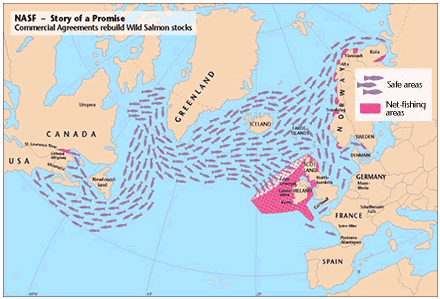
|
|
Hope for Atlantic wild
salmon stocks
"The future of the Atlantic salmon is beginning to look brighter with almost every passing month." So said Orri Vigfússon, Chairman of the North Atlantic Salmon Fund (NASF), at its headquarters in Reykjavik, Iceland, recently. NASF has been instrumental in pioneering environmental agreements with a number of countries, agreements that are based on commercial principles and state support. These agreements also depended on the voluntary co-operation of commercial salmon fishermen. "But", added Mr. Vigfússon, "there is little point in protecting the salmon on their oceanic feeding grounds if they are then to be intercepted by nets along the coasts of Ireland. If stocks are to rebuild they must be given the chance to return to their native rivers and spawn. Mutually-acceptable agreements and new and sustainable employment for fishermen will open the way for this to be done," said Mr. Vigfússon. The map below vividly illustrates the threat to salmon stocks by commercial netting around the coasts of Ireland.
Both Ireland and Canada share a vital interest in the Atlantic wild salmon fishery. As narrated by Noel Carr of FISSTA, the Federation of Irish Salmon and Seatrout Anglers, NASF was initially driven by the urgency to provide safety for the salmon while the fish were on their high seas feeding grounds off Greenland, Iceland and Faroe Islands. This led to the first commercial agreements with long-liners in the Faroe Islands and netsmen in Greenland. The Canadian Government, at great expense to itself, followed these same principles by financing similar agreements with its fishermen in the coastal waters of their eastern seaboard. The second phase of NASF's plan resulted in the completion of agreements in Iceland, Wales, South West England, the North Sea and in the Northern Ireland Conservancy area. These agreements have stopped the decline in wild salmon stocks and rod anglers are beginning to see improvements in a number of regions, particularly in the reappearance of the bigger salmon that after more than one winter's feeding in the sea return to spawn with the largest numbers of eggs "The agreements that have been reached so far have already boosted salmon runs in our rivers" said Mr. Carr. "We have campaigned for what support we can get for these projects, and Irish commercial netsmen (95%) and anglers (5% of national catch) are reaping the benefit of these fish saved from other commercials nets in the North Atlantic countries. It therefore makes no sense to change the point of slaughter from the North Atlantic to our West of Ireland coastline". NASF hopes to launch its third and final phase to provide safety for the salmon by extending its protection to the migration routes the fish take as they return from their oceanic feeding grounds. Said Mr Vigfússon Already very large numbers of commercial fishermen are prepared to cooperate with the NASF teams with the aim of rebuilding stocks to the high levels that existed only two decades ago. A pilot scheme is being prepared in Norway and most of the drift-net and draft-net men in Ireland have indicated willingness to negotiate. Partnership agreements would have huge potential for the development of tourist angling in these regions. In financing its agreements, NASF seeks to encourage the free-market profit motive. It has led the way by raising very considerable private funds. But it also expects the public sector to play its part by contributing a fair share of the money needed to remedy the damage that ineffective management has inflicted on salmon stocks in the past. "We have come a long way already and we can be proud of what we have achieved," said Mr. Vigfússon. FISSTA is a founding member of The North Atlantic Salmon Fund. --30--
Home | About | Canadian Vindicator | Literature | Gallery | History
|
||||||||||||||||||||||||||||||||||||||||||||||||||||||||||||||||||||||||||||||||||||
